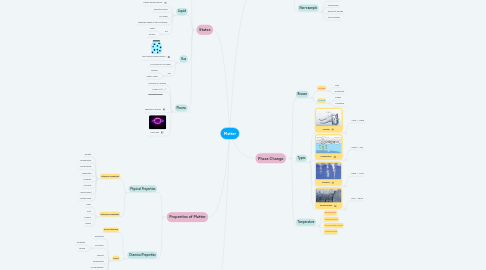
1. States
1.1. Solid
1.1.1. tightly packed atoms can vibrate
1.1.2. Definite shape and volume
1.1.3. e.g.
1.1.3.1. Ice
1.1.3.2. Pencil
1.2. Liquid
1.2.1. loosely packed atoms
1.2.2. Definite volume
1.2.3. No shape
1.2.4. takes the shape of their container
1.2.5. e.g
1.2.5.1. water
1.2.5.2. alcohol
1.3. Gas
1.3.1. very loosely packed atoms
1.3.2. No volume or No shape
1.3.3. e.g.
1.3.3.1. Oxygen
1.3.3.2. Water Vapor
1.4. Plasma
1.4.1. common in Universe
1.4.2. a mass of (+ , - )
1.4.3. spheres of plasma
1.4.4. neon sign
2. Properties of Matter
2.1. Physical Properties
2.1.1. Intensive Properties
2.1.1.1. Density
2.1.1.2. Temperature
2.1.1.3. Conductivity
2.1.1.4. Magnetism
2.1.1.5. Solubility
2.1.1.6. Viscosity
2.1.1.7. Boiling Point
2.1.1.8. Melting Point
2.1.2. Extensive Properties
2.1.2.1. Mass
2.1.2.2. Size
2.1.2.3. Volume
2.1.2.4. Shape
2.2. Chemical Properties
2.2.1. all are intensive
2.2.2. types
2.2.2.1. Reactivity
2.2.2.2. Corrosion
2.2.2.2.1. Oxidation
2.2.2.2.2. Tarnish
2.2.2.3. Toxicity
2.2.2.4. Flammability
2.2.2.5. Combustibility
2.2.2.6. Radioactivity
2.2.2.7. pH
3. Matters are changing
3.1. Types
3.1.1. Physical Changing
3.1.2. Chemical Changing
3.1.2.1. A new substance produced
3.1.2.2. Light
3.1.2.3. Bubbles (gas)
3.1.2.4. A color change
3.1.2.5. A new smell
3.1.2.6. A temperature change
3.2. Conservation of Mass
3.2.1. During a change, the mass is conserved.
4. What is matter?
4.1. Volume
4.1.1. It takes up space
4.2. Mass
4.2.1. Amount of stuff
4.3. Made of Atoms
4.3.1. Atoms : The basic blocks of matter
4.3.1.1. too small to be seen
4.3.1.2. It makes up all the different matter
4.4. Non-example
4.4.1. Light energy
4.4.2. Heat energy
4.4.3. Electricity energy
4.4.4. Sound energy
5. Phase Change
5.1. Reason
5.1.1. Heating
5.1.1.1. Melt
5.1.1.2. Evaporate
5.1.2. Cooling
5.1.2.1. Freeze
5.1.2.2. Condense
5.2. Types
5.2.1. Melting
5.2.1.1. Solid -> Liquid
5.2.2. Evaporation
5.2.2.1. Liquid -> Gas
5.2.3. Freezing
5.2.3.1. Liquid -> Solid
5.2.4. Condensation
5.2.4.1. Gas -> Liquid
5.3. Temperature
5.3.1. Boiling point
5.3.2. Freezing point
5.3.3. Condensation point
5.3.4. Melting point
